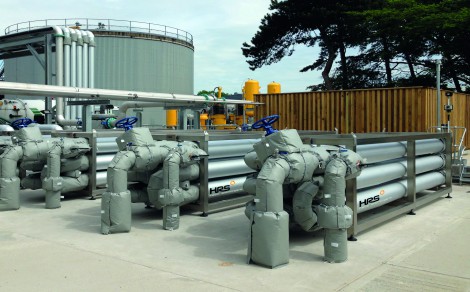- Home » Editorial » Hydraulics
Spiral or corrugated tube heat exchangers – which is best for wastewater treatment?

By Matt Hale, international sales & marketing director, HRS Heat Exchangers.
Since the first spiral heat exchanger was proposed back in the 19th century, they have become synonymous with the treatment of slurries and wastewater; materials which have a high fouling risk, are viscous, or which contain fibres and solid materials. However, in many situations the performance of a corrugated tube heat exchanger is equal to or better than that of a spiral design. Not only that, but corrugated tube designs provide a number of additional advantages in terms of day-to-day operation and maintenance.
Proponents of spiral heat exchangers (sometimes known as shell and coil heat exchangers) cite the following advantages as making them suitable for handling challenging fluids:
1. Good thermal performance, even where the temperature difference between the two materials is small
2. The spiral design and use of a single channel is claimed to prevent fouling and be ‘self-cleaning’
3. Compact design makes them suitable for installations where space and/or access is restricted
4. The counter-current flow provides an effective way to recover waste heat
Based on such claims, it would seem that spiral heat exchangers are the ideal option for high-fouling wastewater and sludge situations. However, given how frequently clients choose to replace their existing spiral heat exchangers (SHEs) with corrugated tube units, some of these claims need closer inspection.
Thermal performance
There is no doubt that in theory SHEs offer greater thermal efficiency than conventional smooth surface tubular designs due to their large surface area and true counter-current flow. However, this assumes that the barrier between the product and service fluids is kept clean and operates efficiently at all times. In practice, fouling frequently occurs, interfering with thermal transfer. Where the heat exchanger is used for sludge-to-sludge applications, this fouling layer can create a double barrier to efficient heat transfer.
While these comparisons hold true for smooth tube heat exchangers, they do not always apply to corrugate tube heat exchangers. For example, like SHEs, the tube-in-tube HRS DTI Series is a true counter-current heat exchanger with the product flowing through the inner tube, and the service fluid flowing through the surrounding shell. The use of HRS corrugation technology increases heat transfer and operational efficiency, while also minimising fouling.
Non-fouling and ‘self-cleaning’ designs
The design of SHEs can create turbulent flow inside the exchanger. In turn this is claimed to reduce the likelihood of fouling, and that where blockages do start to occur, product flow speeds up; creating a ‘scrubbing’ effect that dislodges the blockage (so-called ‘self-cleaning’). This is fine in theory, but in our experience is unlikely in many real-world situations, particularly where SHEs are used with sludge. In fact, when you read further into manufacturers’ brochures, ‘self-cleaning’ often becomes ‘virtually no fouling and clogging’ – two very different claims.
-
PPMA 2025
23 September, 2025, 9:30 - 25 September, 2025, 16:00
NEC, Birmingham UK -
Advanced Engineering Show 2025
29 October, 2025, 9:00 - 30 October, 2025, 16:00
NEC, Birmingham UK










